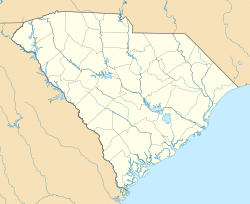
Ashland Park is a historic early 20th century neighborhood in Lexington, Kentucky, United States. It was named after Ashland, the estate of Kentucky statesman Henry Clay which is located in the eastern portion of the neighborhood. The 600-acre (2.4 km2) development was designed by the famous landscape architecture firm the Olmsted Brothers of Massachusetts. The neighborhood belongs to the National Register of Historic Places.
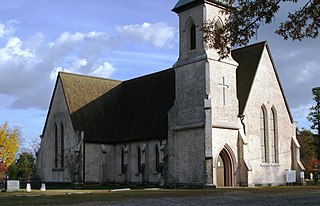
The Church of the Holy Cross is a historic Anglican church at 335 North Kings Highway in Stateburg, South Carolina. Built in 1850-52 to a design by noted South Carolina architect Edward C. Jones, it is a notable example of rammed earth construction with relatively high style Gothic Revival styling. It was designated a National Historic Landmark for its architecture in 1973. In 2013, the Church of the Holy Cross disaffiliated with the Episcopal Church and realigned with the Anglican denomination.
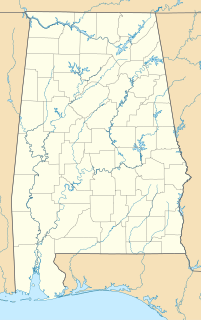
The Church Street East Historic District is a historic district in the city of Mobile, Alabama, United States. It was placed on the National Register of Historic Places on 16 December 1971. Since a boundary increase on 13 January 1984, it is roughly bounded by Broad, Conti, Water, Claiborne, and Canal Streets. 20 April 2005 saw the further addition of 66 & 68 Royal Street to the district. The district covers 1,403 acres (5.68 km2) and contains 83 contributing buildings and one object. It contains portions of Mobile's 19th century downtown area and features government, museum, commercial, and residential structures in a variety of 19th-century styles. The buildings range in age from the 1820s to 1900 and include the Federal, Greek Revival, Renaissance Revival, Italianate, and various other Victorian architectural styles. Notable buildings include the Government Street Presbyterian Church, Barton Academy, and the Ketchum House.

Beaufort Historic District is a historic district in Beaufort, South Carolina. It was listed on the National Register of Historic Places in 1969, and was declared a National Historic Landmark in 1973.

The Charleston Historic District, alternatively known as Charleston Old and Historic District, is a National Historic Landmark District in Charleston, South Carolina. The district, which covers most of the historic peninsular heart of the city, contains an unparalleled collection of 18th and 19th-century architecture, including many distinctive Charleston "single houses". It was declared a National Historic Landmark in 1960.

Carter Hill is a historic plantation complex located near Camden, Kershaw County, South Carolina. The overseer's house was built about 1840, and now incorporated into the main house built about 1875. The overseer's house was a one-room house, that incorporates architectural elements in the Greek Revival style. The main house reflects the rural Victorian architectural style predominant after the American Civil War. Also on the property are a log building, a frame building, a pump house, a smokehouse, a dovecote, a hen house, and a barn constructed at various times during the 19th century. It was listed on the National Register of Historic Places in 1992.
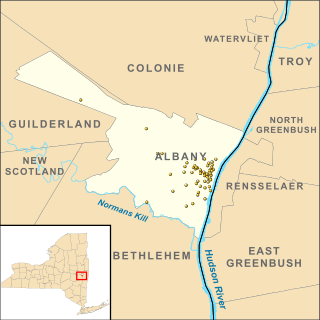
There are 69 properties listed on the National Register of Historic Places in Albany, New York, United States. Six are additionally designated as National Historic Landmarks (NHLs), the most of any city in the state after New York City. Another 14 are historic districts, for which 20 of the listings are also contributing properties. Two properties, both buildings, that had been listed in the past but have since been demolished have been delisted; one building that is also no longer extant remains listed.

The Shepard Street–South Road Street Historic District is a national historic district located at Elizabeth City, Pasquotank County, North Carolina. The district encompasses 161 contributing buildings in a historically African-American section of Elizabeth City. The district developed from the mid-19th to mid-20th century, and includes representative examples of Greek Revival, Gothic Revival, Italianate, Queen Anne, Colonial Revival, Bungalow, and American Foursquare style architecture. Notable contributing buildings include the Sawyer–Pailin–Overman House, Antioch Presbyterian Church, (former) St. Catherine Catholic Church (1941), Olive Branch Missionary Baptist Church (1904), Corner Stone Missionary Baptist Church (1888), (former) St. Phillips Episcopal Church (1893), the Sundry Shop, Rex Cleaning Works (1932), Good Samaritan Hall (1896), and Republican Star Odd Fellows Hall.

Conway Residential Historic District is a national historic district located at Conway in Horry County, South Carolina. It encompasses 125 contributing buildings and one contributing object. It includes a variety of quality 19th and 20th-century residential buildings, until about 1955. The residential buildings reflect a variety of popular architectural styles including Greek Revival, Carpenter Gothic Revival, Queen Anne, Italianate, and Tudor and Colonial Revival. The District also contains four apartment buildings, one school, a church, and a Confederate monument. Four properties in this historic district were previously listed: the Beaty-Little House, the Burroughs School, the J.W. Holliday Jr. House, and the W. H. Winborne House.
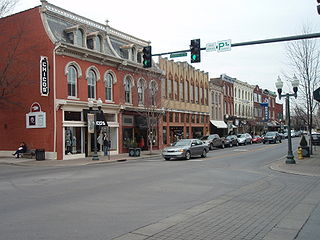
Franklin Historic District is a historic district in Franklin, Tennessee that was listed on the National Register of Historic Places in 1972. It was created to preserve historic commercial and residential architecture in a 16-block area of the original, downtown Franklin around the north, west, and south of the town square.

The city of Anderson, South Carolina, began in 1826 with the formation of Anderson County. The amount of cotton being grown in the area allowed for the construction of mills and the town developed. Specific to the Anderson Historic District, much is residential and the homes show a number of different architectural styles, including Greek Revival, Romanesque Revival, Victorian, and Colonial Revival. Some modern buildings have been interspersed in the district, but much of the very accessible area is historically intact. The Anderson Historic District was listed in the National Register on December 13, 1971.

The Caldwell-Johnson-Morris Cottage is located in Anderson, South Carolina. It was constructed around 1851, and is historically significant because it illustrates the “raised cottage” genre of architecture, a style that became popular in the 19th century.
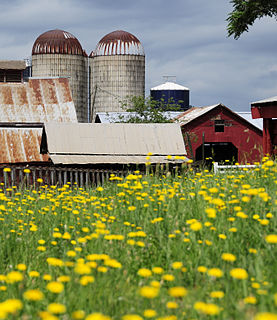
Denver Downs Farmstead, also known as Garrison Farm, is an historic farm on the outskirts of Anderson, South Carolina.

The Kennedy Street School is located near the downtown area of Anderson, South Carolina. It was constructed in 1913, and is considered historically significant primarily because its architectural style is considered representative and typical of the Commercial style with Classical Revival details favored in the first quarter of the 20th century. The auditorium, added in 1960, is an excellent example of Modern style architecture. The 1913 school building was designed by architect Joseph Huntley Casey of Anderson, S.C. The Kennedy Street School was listed in the National Register on October 24, 2007.

The Ralph John Ramer House, is located near the downtown area of Anderson, South Carolina. The house was built in 1930 and is historically significant as an excellent example of an early-20th century Tudor Revival residence. Ramer was a leading Anderson businessman, government official, military officer and civic leader. Much of the noteworthy architectural detail of this house can be viewed from the public road that fronts the grounds. The house was listed in the National Register on February 10, 1992.

The West Chapel Hill Historic District is a national historic district in Chapel Hill, North Carolina. The district comprises several small neighborhoods and is roughly bounded by West Cameron Avenue, Malette Street, Ransom Street, Pittsboro Street, University Drive and the Westwood Subdivision. The district was added to the National Register of Historic Places in 1998, and was enlarged in 2019. The district encompasses an upper-middle class residential neighborhood that developed during the nineteenth and twentieth centuries. The growth of the district is related to the development of the University of North Carolina at Chapel Hill and the town of Chapel Hill.

Edgefield Historic District is a national historic district located at Edgefield, Edgefield County, South Carolina. The district encompasses 33 contributing buildings, 6 contributing sites, and 1 contributing object in the town of Edgefield. The buildings center on the landscaped village green, and includes forty 19th century buildings, three of which are house museums. There are a number of 19th century Greek Revival style homes, while others are noted for beautiful Federal style fanlights and unusual doorways. Other district properties include Victorian influenced homes and downtown commercial buildings. Five churches represent the Georgian, Victorian Gothic, and modified Gothic architectural styles. Notable buildings include the Edgefield County Courthouse, Trinity Episcopal Church and Rectory, St. Mary's Catholic Church, Halcyon Grove, Oakley Park, Carroll Hill, Blocker House, Yarborough House, and Padgett House.

South King Street Historic District is a national historic district located at Morganton, Burke County, North Carolina. It encompasses 10 contributing buildings in Morganton. It includes residential, religious, and educational buildings built between about 1893 and 1939. It includes representative examples of Colonial Revival, Georgian Revival, and Gothic Revival style architecture. Notable buildings include the Grace Episcopal Church, Morganton Library, and Works Progress Administration constructed nurses' home.

Masonboro Sound Historic District is a national historic district located near Wilmington, New Hanover County, North Carolina. The district encompasses 22 contributing buildings, 2 contributing sites, 8 contributing structures, and 1 contributing object near Wilmington. The district developed during the 19th and early-20th century and includes notable examples of Italian Renaissance and Colonial Revival style architecture. There are 10 contributing dwellings and 13 contributing outbuildings. Notable dwellings include the Carr-Ormand House (1932), Willard-Sprunt-Woolvin House (1880), Cazaux-Williams-Crow House, Parsley-Love House, Live Oaks (1913), Taylor-Bissinger House (1937), the "Doll House" (1924), and Hill-Anderson Cottage.

Mordecai Place Historic District is a historic neighborhood and national historic district located at Raleigh, North Carolina. The district encompasses 182 contributing buildings and 1 contributing object in the most architecturally varied of Raleigh's early-20th century suburbs for the white middle-class. Mordecai Place was listed on the National Register of Historic Places in February 1998, with a boundary increase in 2000.

